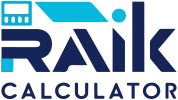Introduction to Return on Assets (ROA)
The Return on Assets (ROA) is a vital financial metric used by investors and analysts to assess how efficiently a company utilizes its assets to generate profit. Understanding how to calculate return on assets is essential for anyone looking to evaluate a company’s performance. This calculator simplifies the process, allowing you to quickly determine the ROA and gain insights into a company’s asset management.
What is Return on Assets?
Return on Assets is a financial ratio that indicates the percentage of profit a company earns for each dollar of assets it owns. In simpler terms, it shows how well a company uses its assets to produce earnings. A higher ROA suggests more efficient management of assets, while a lower ROA can indicate potential issues in asset utilization.
Importance of ROA
- Performance Indicator: ROA provides a clear view of a company’s operational efficiency.
- Investment Analysis: Investors use ROA to compare companies within the same industry.
- Trend Analysis: Tracking ROA over time can help identify improvement or decline in asset efficiency.
How to Calculate Return on Assets
To calculate return on assets, you can use the following formula:
ROA Formula
ROA = Net Income / Total Assets
Where:
- Net Income is the total profit of the company after all expenses have been deducted.
- Total Assets includes all the assets owned by the company, such as cash, inventory, property, and equipment.
Steps to Calculate Return on Assets
- Gather Financial Statements: Obtain the company’s income statement and balance sheet.
- Identify Net Income: Find the net income figure, which is usually located at the bottom of the income statement.
- Determine Total Assets: Look for the total assets figure, typically found on the balance sheet.
- Apply the Formula: Divide the net income by the total assets to calculate ROA.
Return on Assets Calculation Example
To illustrate how to calculate return on assets, let’s look at a hypothetical company:
- Net Income: $150,000
- Total Assets: $1,000,000
Using the ROA formula:
ROA = $150,000 / $1,000,000 = 0.15 or 15%
This means the company earns 15 cents for every dollar of assets it owns.
Return on Total Assets Calculation
Understanding the return on total assets calculation is crucial for comprehensive financial analysis. This metric provides insight into how effectively a company utilizes its entire asset base, reflecting both operational efficiency and overall profitability.
Factors Affecting ROA
Several factors can impact a company’s ROA, including:
- Asset Structure: Companies with high fixed assets may have lower ROA due to high depreciation.
- Profit Margins: Higher profit margins lead to higher ROA, as net income increases relative to assets.
- Industry Norms: Different industries have varying asset requirements, influencing typical ROA values.
Benefits of Using a Return on Assets Calculator
Using a Return on Assets Calculator offers several advantages:
- Quick Calculations: Instantly compute ROA without manual calculations.
- Multiple Scenarios: Analyze different financial scenarios by adjusting inputs to see how ROA changes.
- Comparison Tool: Easily compare ROA across different companies or periods.
Conclusion
The Return on Assets Calculator is an essential tool for anyone interested in understanding a company’s financial performance. By learning how to calculate return on assets and interpreting the results, you can make more informed decisions about investments and evaluate a company’s efficiency in utilizing its assets.
Key Takeaways
- ROA measures a company’s efficiency in using its assets to generate profit.
- The calculation involves dividing net income by total assets.
- A Return on Assets Calculator simplifies the process and aids in financial analysis.
